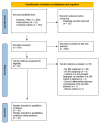Are There Benefits of Total Hip Arthroplasty with Dual-Mobility Cups Compared to Bipolar Hemiarthroplasty for Femoral Neck Fractures in the Geriatric Population? A Systematic Review and Meta-Analysis of Comparative Studies
- PMID: 40725766
- PMCID: PMC12295041
- DOI: 10.3390/jcm14145076
Are There Benefits of Total Hip Arthroplasty with Dual-Mobility Cups Compared to Bipolar Hemiarthroplasty for Femoral Neck Fractures in the Geriatric Population? A Systematic Review and Meta-Analysis of Comparative Studies
Abstract
Background/Objectives: The optimal treatment for femoral neck fractures (FNFs) in the elderly remains unclear. Internal fixation, bipolar hip hemiarthroplasty (BH), standard total hip arthroplasty (THA), or dual mobility (DM-THA) cups have been employed, each presenting various advantages and disadvantages. This systematic review and meta-analysis evaluated comparative studies of BH and DM-THA in FNFs among the elderly, aiming to ascertain differences in outcomes, including functional recovery, patient-reported outcome measures, implant survival, complications, and mortality rates. Methods: This meta-analysis followed PRISMA 2020 guidelines with a pre-registered PROSPERO protocol (CRD420251065762). A comprehensive search of electronic databases and grey literature included only comparative studies of BH and DM-THA in patients over 65 years with FNFs. Results: Sixteen studies were eligible, comprising four randomised controlled trials and twelve retrospective comparative studies involving 11,460 patients (10,036 BH; 1424 DM-THA). Patients with DM-THA exhibited a higher postoperative Harris Hip Score (4.55, p < 0.0001), alongside a lower dislocation risk ([OR] 2.77, p < 0.0001), a reduced revision rate ([OR] 2.36, p < 0.0001), and decreased mortality ([OR] 1.94, p < 0.0001). The operative time was somewhat longer in the DM-THA group, by 12.71 min, and blood loss was greater by 121 mL, indicating significant heterogeneity across the studies. Conclusions: DM-THA for FNFs in elderly patients results in improved functional recovery and lower dislocation, reoperation, and mortality risk. However, longer operative times and increased blood loss remain significant considerations. Further, well-designed comparative studies are required to evaluate overall cost-effectiveness and define the optimal age threshold, beyond which the limitations of DM-THA may outweigh its benefits.
Keywords: complications; femoral neck fractures; frail elderly; hemiarthroplasty; meta-analysis; reoperation; survival; total hip arthroplasty.
Conflict of interest statement
The authors declare no conflicts of interest.
Figures







Similar articles
-
Hip arthroplasty for acute femoral neck fracture: Hemiarthroplasty, dual mobility, or conventional total hip arthroplasty? A comparative analysis of 37,169 hip arthroplasties from the Swiss National Joint Registry.Orthop Traumatol Surg Res. 2025 Jul 9:104331. doi: 10.1016/j.otsr.2025.104331. Online ahead of print. Orthop Traumatol Surg Res. 2025. PMID: 40645446
-
Are There Differences in Performance Among Femoral Stem Brands Utilized in Cementless Hemiarthroplasty for Treatment of Geriatric Femoral Neck Fractures?Clin Orthop Relat Res. 2025 Feb 1;483(2):253-264. doi: 10.1097/CORR.0000000000003222. Epub 2024 Aug 15. Clin Orthop Relat Res. 2025. PMID: 39158389
-
Surgical interventions for treating intracapsular hip fractures in older adults: a network meta-analysis.Cochrane Database Syst Rev. 2022 Feb 14;2(2):CD013404. doi: 10.1002/14651858.CD013404.pub2. Cochrane Database Syst Rev. 2022. PMID: 35156192 Free PMC article.
-
Risk of revision and dislocation in single, dual mobility and large femoral head total hip arthroplasty: systematic review and network meta-analysis.Eur J Orthop Surg Traumatol. 2018 Apr;28(3):445-455. doi: 10.1007/s00590-017-2073-y. Epub 2017 Nov 8. Eur J Orthop Surg Traumatol. 2018. PMID: 29119371
-
Surgical approaches for inserting hemiarthroplasty of the hip in people with hip fractures.Cochrane Database Syst Rev. 2025 Jun 13;6(6):CD016031. doi: 10.1002/14651858.CD016031. Cochrane Database Syst Rev. 2025. PMID: 40511667 Review.
References
-
- Beauchamp-Chalifour P., Pelet S., Belhumeur V., Angers-Goulet M., Bédard L., Belzile E.L. Should We Use Bipolar Hemiarthroplasty in Patients ≥70 Years Old with a Femoral Neck Fracture? A Review of Literature and Meta-Analysis of Randomized Controlled Trials. J. Arthroplast. 2022;37:601–608. doi: 10.1016/j.arth.2021.12.004. - DOI - PubMed
Publication types
LinkOut - more resources
Full Text Sources

